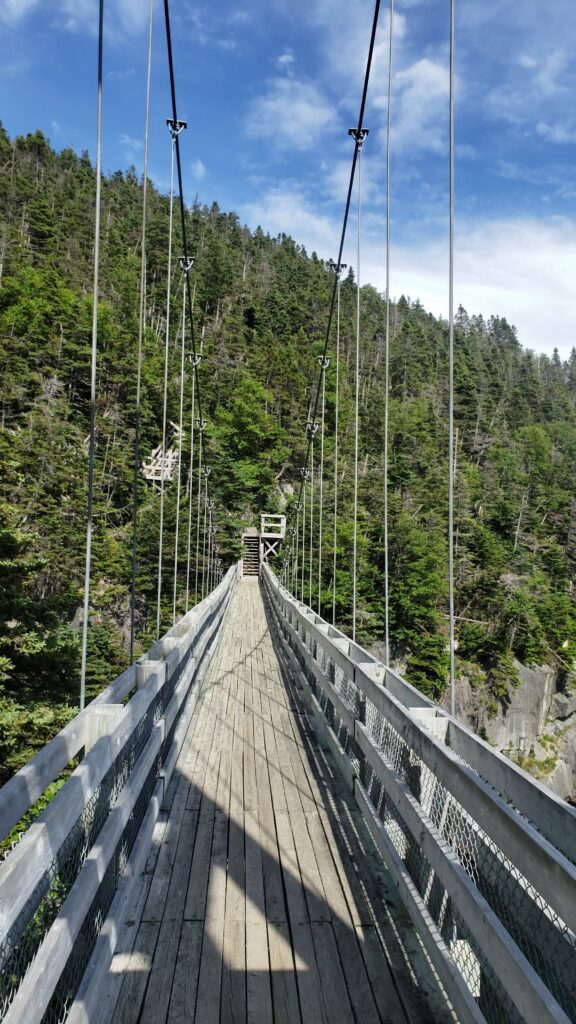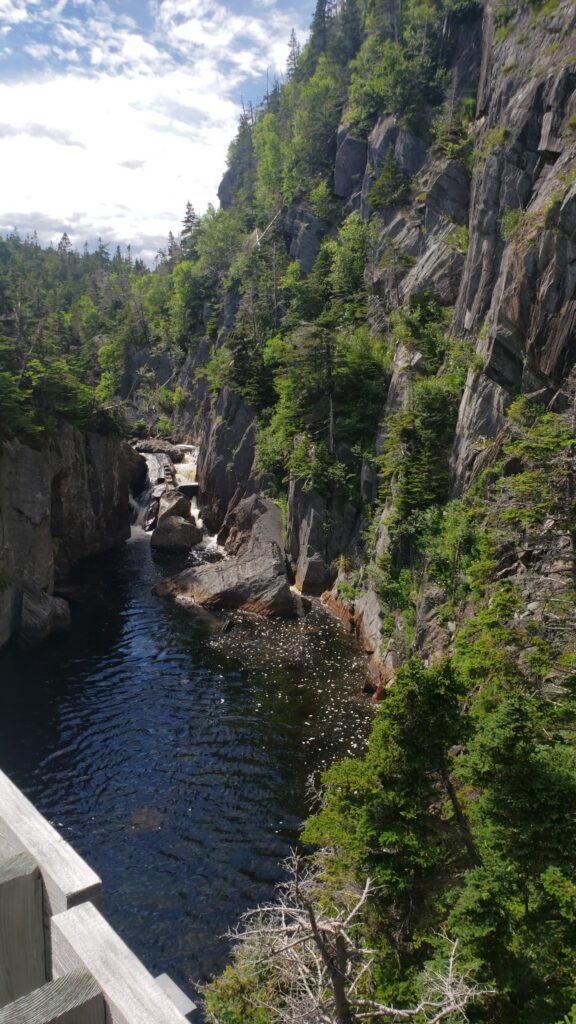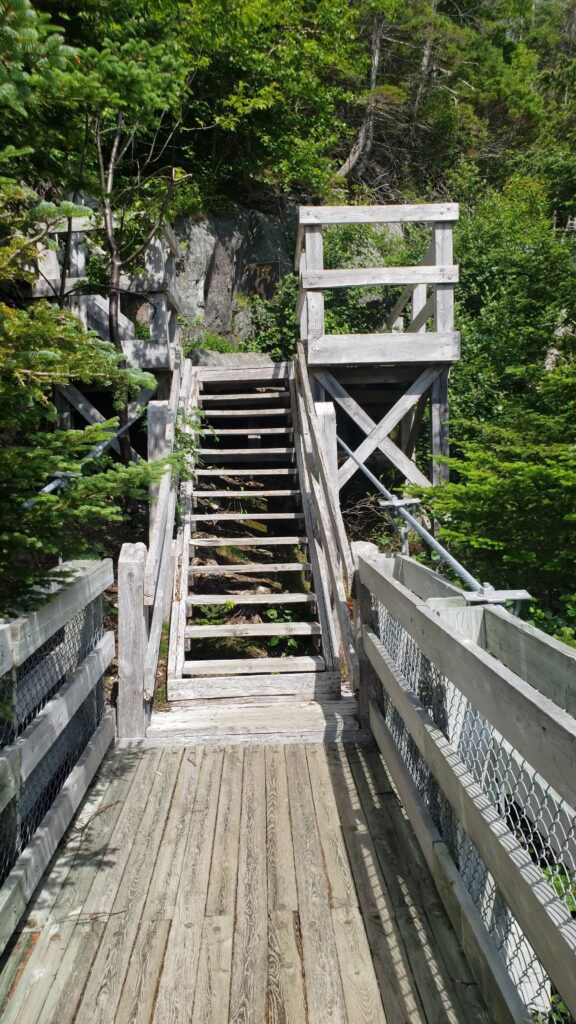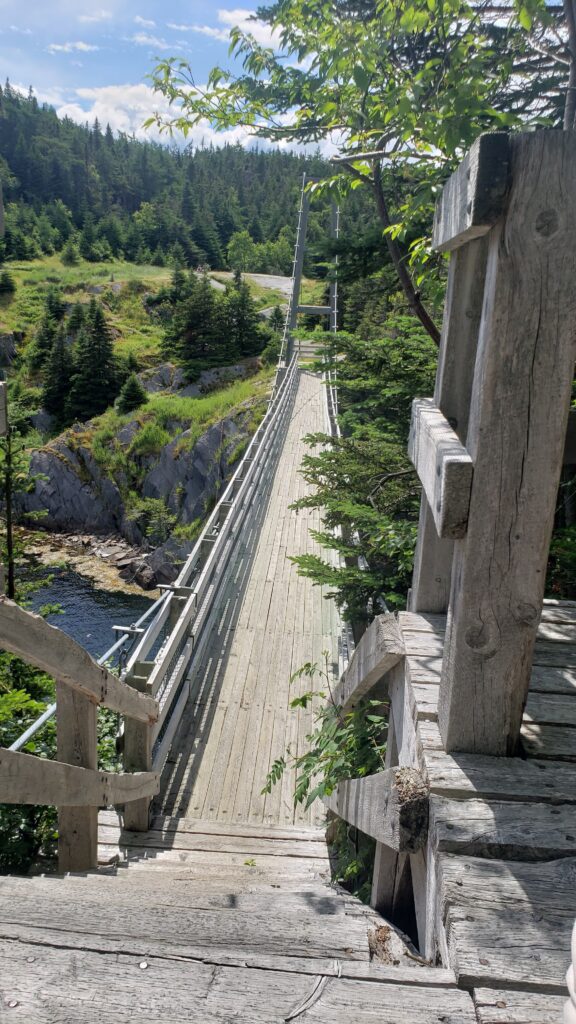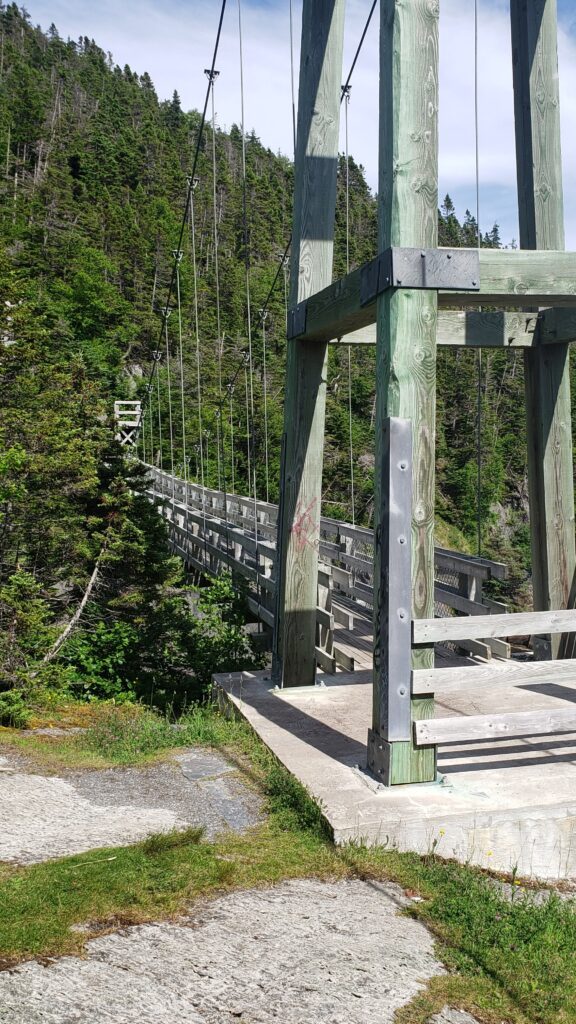LaManche Suspension Bridge is a suspension bridge crossing the LaManche River. The Suspension Bridge is a beautiful structure located in the LaManche Provincial Park.
The bridge spans over 35 meters and is complemented by a long hiking trail and picnic area for you to enjoy. A thrilling hiking experience can be found in LaManche on your way to the Suspension Bridge.
The park, trails and bridge are beautiful, with picturesque views of a river, swimming holes, and cliffs. This unique place has been around for a long time, and many hikers walk the path to the bridge every summer to experience crossing the bridge.
The bridge spans over the LaManche River, offering hikers a stunning view of the surrounding area. The bridge is a defining feature of LaManche Provincial Park. The park has a diverse ecosystem where several forms of wildlife thrive. The area itself boasts stunning views and is an extremely pleasant place to hike and enjoy with family. Exploring Newfoundland, here is Everything You Need to Know About Traveling to Newfoundland and Labrador. Are you planning on spending time in St John’s? Here is Everything you need to know about St John’s and the Avalon Region
How to get to La Manche Suspension Bridge?
You will drive on the dirt road for about 5 minutes and hike to the bridge. The hike will take you about 45 minutes from where you park.
Did you know LaManche was a French community? Watch this video to learn more about this extremely interesting place.
How long is the La Manche Trail?
The La Manche Trail, part of the East Coast Trail network in , spans approximately 6.4 kilometres one-way from the trailhead at La Manche Provincial Park to the suspension bridge over La Manche River. The trail offers scenic coastal views and rugged landscapes.
How long does it take to hike to La Manche suspension bridge?
The hike to the La Manche suspension bridge typically takes about 30 to 40 Minutes one-way, depending on the hiker’s pace and the trail conditions. The journey is moderately challenging, with some steep sections and rocky terrain, but the stunning views and the experience of crossing the suspension bridge make it well worth the effort.
What is the history of La Manche, Newfoundland?
La Manche, located on the Avalon Peninsula, has a rich and storied history. Originally a tiny fishing village, La Manche was settled by families attracted to the area’s rich fishing grounds. The town thrived for over a century the residents engaged in inshore fishing and utilized the nearby natural resources to sustain their community. However a severe storm caused massive damage to the village, including destroying the fishing stages, boats, and homes. The storm’s impact was so devastating that the residents abandoned La Manche, leaving behind their homes and the remnants of their lives.
What is La Manche known for?
La Manche is primarily known for its scenic beauty, historical ruins, and the La Manche suspension bridge. The area is a favourite among hikers and nature enthusiasts who come to explore the La Manche Trail and experience the rugged coastline, dense forests, and diverse wildlife. The suspension bridge, which spans the La Manche River, is a highlight for visitors, providing breathtaking views and a sense of adventure.
In addition to its natural attractions, La Manche’s historical significance as a former fishing village adds to its charm. The ruins of the old town, including stone foundations and remnants of buildings, tell the story of the community that once thrived there.
What happened to La Manche?
La Manche was abandoned following the catastrophic storm which caused irreparable damage to the village’s infrastructure. The storm destroyed fishing stages, boats, and homes, making it impossible for the residents to continue their way of life. Faced with the daunting task of rebuilding and losing their primary means of livelihood, the villagers made the difficult decision to leave La Manche.
Today, the site of the former village is a historical landmark within La Manche Provincial Park. Visitors can explore the ruins, hike the La Manche Trail, and cross the suspension bridge, gaining an appreciation for the area’s history and natural beauty. The story of La Manche serves as a testament to the resilience and tenacity of the people who once called it home, as well as a reminder of the powerful forces of nature that shaped their lives.
Visitors should be prepared for the hike with proper footwear, water, and snacks, as the trail can be challenging in sections. The trailhead is accessible from La Manche Provincial Park, which also offers camping and other amenities for those wishing to extend their stay and explore more of the East Coast Trail network.
Travelling to Newfoundland and Labrador. Travelers also ask.

Is St. John’s, Newfoundland, worth visiting?
St. John’s, Newfoundland and Labrador’s capital city, is worth visiting. This vibrant city uniquely blends history, culture, and natural beauty. With its colourful row houses, historic sites, and stunning views from Signal Hill, St. John’s offers a distinctive charm that captivates visitors. The city’s friendly atmosphere and rich cultural heritage make it an excellent destination for travellers seeking an authentic experience.
What is St. John’s most known for?
St. John’s is most known for its colourful row houses, often called “Jellybean Row,” its rich Atlantic history, and is the easternmost city in North America. The city is also famous for Signal Hill, where the first transatlantic signal was received. St. John’s is also renowned for its vibrant arts scene, lively music festivals, and friendly, welcoming residents.
Is St John’s a walkable city?
St. John’s is considered a walkable city, especially in its downtown area. The city’s compact size, picturesque streets, and numerous attractions make it easy to explore on foot. Visitors can enjoy walking through the historic neighbourhoods, visiting local shops, and dining at various restaurants without needing a car. However, the city’s hilly terrain can be challenging for some, so comfortable walking shoes are recommended.
What food is St John’s known for?
St. John’s is known for its unique and delicious seafood dishes. The city is famous for its fresh cod, often served as fish and chips, as well as cod tongues and scrunchions (fried pork fat). Another popular dish is Jigg’s dinner, a traditional Newfoundland boiled dinner featuring salt beef, cabbage, potatoes, and carrots. Additionally, the city offers berry-based desserts, thanks to the abundance of local wild berries like partridgeberries and bakeapples.
Why is Newfoundland so cheap?
Newfoundland is relatively affordable due to its lower cost of living than other parts of Canada. Housing costs, in particular, are lower, contributing to overall affordability. Additionally, the province’s economy is less heavily influenced by significant industries like finance or technology, often driving up living costs in other regions. However, it’s important to note that while some aspects are cheaper, the cost of imported goods can be higher due to the island’s remote location.
What is the best month to visit Newfoundland?
The best month to visit Newfoundland is typically July or August. During these summer months, the weather is comfortable, with temperatures ranging between 14°C to 26°C. This is also the best time to enjoy hiking, whale watching, and exploring the scenic coastline. Additionally, festivals and events take place during the summer, providing a lively atmosphere for visitors.
What is the famous street in St John’s?
The most famous street in St. John’s is George Street. Known for its vibrant nightlife, George Street has the highest concentration of bars and pubs per capita in North America. This bustling street comes alive at night with live music, entertainment, and a lively crowd. It is a must-visit for those looking to experience the city’s nightlife and enjoy a variety of local brews and spirits.
Why should I go to St John’s?
You should visit St. John’s for its unique history, culture, and natural beauty blend. The city offers stunning coastal views, historic landmarks, and a welcoming atmosphere. Visitors can explore the colourful Jellybean Row houses, hike up to the top of Signal Hill for panoramic views, and immerse themselves in the local arts and music scene. Additionally, St. John’s provides access to some of the most breathtaking landscapes in Newfoundland, making it an excellent base for further exploration of the province.
Is St. John’s the oldest city in Canada?
Yes, St. John’s is the oldest city in Canada. The city’s long history is evident in its well-preserved architecture, historic sites, and museums, which glimpse its rich past.
What food is only found in Newfoundland?
One food that is unique to Newfoundland is the “touton.” A touton is a traditional Newfoundland bread dough fried until golden brown, often served with molasses or syrup. Another unique item is “cod tongues,” a local delicacy made from the small muscles of the codfish’s throat, usually fried and served with scrunchions. These dishes are deeply rooted in the province’s culinary heritage and must-try for visitors.
What is the signature dish of Newfoundland?
The signature dish of Newfoundland is “Jigg’s Dinner.” This traditional meal consists of salt beef, boiled with root vegetables such as potatoes, carrots, turnips, and cabbage. It is often served with pease pudding, a dish made from yellow split peas cooked in a cheesecloth bag. Jigg’s dinner is a staple of Newfoundland cuisine and reflects the island’s cultural and culinary traditions.
Is it safe to drink the water in St John’s?
Yes, it is safe to drink the water in St. John’s. The city’s water supply meets all Canadian drinking water quality guidelines. Tap water in St. John’s is regularly treated to ensure it is safe for consumption. Visitors can feel confident drinking tap water throughout the city.
What is a Newfoundland breakfast?
A Newfoundland breakfast often includes traditional items such as toutons (fried bread dough), fish cakes, and baked beans. Another common component is “Newfoundland-style” baked goods, such as homemade bread or tea biscuits. Salt fish and potatoes are sometimes served, reflecting the province’s Atlantic heritage. This hearty breakfast provides a delicious and filling start to the day.
What is the national drink of Newfoundland?
The national drink of Newfoundland is often considered to be “Screech,” a type of rum that has become synonymous with the province. Screech is a Jamaican rum that was historically traded in Newfoundland, and it is now used in the famous “Screech-In” ceremony, a tradition for welcoming newcomers to the island. This ceremony involves taking a shot of Screech, reciting a short verse, and kissing a codfish.
What four animals cannot be found in Newfoundland?
The four animals that cannot be found in Newfoundland are skunks, porcupines, raccoons, and snakes. The island’s isolation and unique ecosystem mean these species are not native to Newfoundland. This lack of certain animals contributes to the distinctive wildlife experience on the island.
What language is spoken in Newfoundland?
In Newfoundland, English is the predominant language spoken. However, the local dialect, often called “Newfoundland English” or “Newfinese,” is unique and features distinct accents, vocabulary, and expressions influenced by Irish, Scottish, and West Country English settlers. This dialect adds to the province’s rich cultural tapestry and can be distinctive to visitors.
What are toutons?
Toutons are a traditional Newfoundland dish made from bread dough that is fried until golden brown. They are typically served with molasses or syrup, a popular breakfast item. Toutons can be enjoyed plain or with various accompaniments, and they are a beloved part of Newfoundland’s culinary heritage.
Is it safe to walk around St John?
Yes, it is safe to walk around St. John’s. The city has a relatively low crime rate, and most neighbourhoods, especially downtown, are safe for pedestrians.
Is St John’s Newfoundland affordable?
St. John’s, Newfoundland, is considered affordable compared to many other Canadian cities. While certain imported goods might be more expensive due to the island’s location, the cost of living and visiting St. John’s is reasonable overall.
Is Newfoundland expensive to visit?
Newfoundland is not typically considered an expensive destination to visit. Accommodation, food, and activities are generally more affordable than in many major Canadian cities. However, transportation costs can be higher, especially if flying to the island or travelling between remote locations. Despite this, Newfoundland’s unique experiences and natural beauty make it a worthwhile and budget-friendly destination for many travellers.
These are the best travel planning resources you should use.
Looking to book your trip to Newfoundland and Labrador? Use these resources that are tried and tested by other travellers like you who vacation in Newfoundland and Labrador. Bookmark these links. Save them for future reference.
Booking Flights, Hotels or B&B: Start planning your next vacation trip by finding the best flight, hotel or b&b deals. Book Here
Finding things to do in Newfoundland and Labrador on TripAdvisor and Viator is not hard. Enjoy boat tours, whale watching, iceberg watching, kayaking and other activities. You can book all these activities on
You can also find low prices on hotels, B&B and cabins with these two providers. If you are located in Canada, the USA, the UK or Europe, use Booking.com, and if you are in Canada, the USA or anywhere else, use TripAdvisor.
Car Rental: Here is what we recommend:
When you book with Rentalcars.com, You have the power to compare the price and find the best vehicle for your trip. Economybookings.com Display all their vehicle on the website with a detailed description. They display high-quality photos and a user rating as well. Qeeq.com serves road trip travellers like you from different countries by working with car rental companies worldwide.
Get compensated if your flight is delayed or cancel
AirHelp and Compensateair will help you with flight delays, cancellations, or denied boarding. All you need to do is to submit your flight details, and they will handle the claim process on your behalf. They will handle all the paperwork, negotiations with the airlines, and legal proceedings.
Do you need more help planning your trip?
Make sure to check out our Resources Page, where we also highlight all the resources and companies you can use to assist with your planning.

